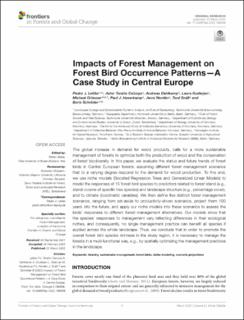Impacts of Forest Management on Forest Bird Occurrence Patterns—A Case Study in Central Europe
Leitão, Pedro J.; Caicoya, Astor Toraño; Dahlkamp, Andreas; Guderjan, Laura; Griesser, Michael; Haverkamp, Paul J.; Nordén, Jenni; Snäll, Tord; Schröder, Boris
Peer reviewed, Journal article
Published version

View/
Date
2022Metadata
Show full item recordCollections
- Publikasjoner fra CRIStin - NINA [2364]
- Scientific publications [1392]
Original version
10.3389/ffgc.2022.786556Abstract
The global increase in demand for wood products, calls for a more sustainable management of forests to optimize both the production of wood and the conservation of forest biodiversity. In this paper, we evaluate the status and future trends of forest birds in Central European forests, assuming different forest management scenarios that to a varying degree respond to the demand for wood production. To this end, we use niche models (Boosted Regression Trees and Generalized Linear Models) to model the responses of 15 forest bird species to predictors related to forest stand (e.g., stand volume of specific tree species) and landscape structure (e.g., percentage cover), and to climate (bioclimatic variables). We then define five distinct forest management scenarios, ranging from set-aside to productivity-driven scenarios, project them 100 years into the future, and apply our niche models into these scenarios to assess the birds’ responses to different forest management alternatives. Our models show that the species’ responses to management vary reflecting differences in their ecological niches, and consequently, no single management practice can benefit all species if applied across the whole landscape. Thus, we conclude that in order to promote the overall forest bird species richness in the study region, it is necessary to manage the forests in a multi-functional way, e.g., by spatially optimizing the management practices in the landscape. forestry, sustainable management, forest birds, niche modeling, scenario projections
